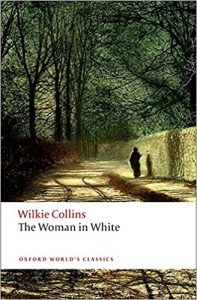
Thanks for sticking with me so far, today’s post is unfortunately my last one! It’s been fun writing this serial journal every day this week, and it’s given me the push to try keeping a personal journal again as well.
For my last post I’ll be looking at The Woman in White. It’s the text that started the semester, so it’s only natural that we end the semester discussing it as well. While reading this text serially, one thing I paid particular attention to was where instalments ended. To look at the way instalments end, I took a look at all the endings and broke them up into three groups: instalment endings at the end of chapters, instalment endings in the middle of chapters, and instalment endings at the end of epochs.
End of Chapter Endings
The most common instalment endings occur at the end of chapters. These tend to end on suspenseful notes to keep readers anticipating the next instalment. When we first began reading The Woman in White, we read the first two instalments together. I had only written down the page number for the end of the second instalment, but I found it really easy to guess where the first instalment ended. The first instalment was four chapters and ended on the line: “Done! She has escaped from my Asylum. Don’t forget: a woman in white. Drive on” (pg. 28). This is a line of dialogue that Walter overheard a person looking for the woman in white say to a police office. It seemed like the perfect place to end an instalment, and unlike the previous chapter endings before it, it ended on a more suspenseful note. The endings work really well because they are cliffhangers.
Middle of Chapter Endings
While the majority of instalments end on chapter endings, there are five that end in the middle of chapters. The first time this happens is the end of the 17th instalment, which ends on this exchange between Laura and Marian:
‘Marian!-the figure at the lake – the footsteps last night – I’ve just seen her! I’ve just spoken to her!’
‘Who, for Heaven’s sake?’
‘Anne Catherick.’ (pg. 279).
These instalments are still ending on suspenseful notes, they just don’t happen at the end of chapters. My best guess is that this happens in order to keep the same general length of instalments. It wouldn’t make sense to end the chapter here because they’re in the middle of a conversation and it’s not a natural stopping point, but it is a natural stopping point for an instalment because it leaves readers wanting to read more.
Epoch Endings
Similar to the other instalment endings, endings of epochs ended on suspenseful notes as well. The first epoch ends with Laura and Sir Percival getting married. It’s Marian’s pov and the last line of the instalment/epoch is: “They are gone! I am blind with crying – I can write no more —” (pg. 197). The second epoch ends with Walter first reading the inscription of Laura’s tombstone: ‘Sacred to the Memory of Laura, Lady Glyde-‘, and then the next line is: “Laura, Lady Glyde, was standing by the inscription, and was looking at me over the grave” (pg. 419).
The difference with these endings however is that they occur during shifts which change the direction of the novel. They split the novel into three main parts: The first part at Limmeridge, the second part at Blackwater, and the third part of the investigation. There are major transitions between the physical spaces that these epochs occur in.
In Conclusion…
Reading a serial instalment is a commitment. It’s a long term relationship. Naturally in order to keep readers invested in a story from week to week, for 40 weeks, readers have to be invested in the characters and want to know what happens to them. By ending instalments on suspenseful notes, readers will want to stick with the story to find out what happens to the character and make sure that they’re okay. I have to admit, I was happy to find that The Woman in White has a happy ending.
#HeirOfLimmeridge and #ThanksMarian
Thanks for reading!
Dessi
